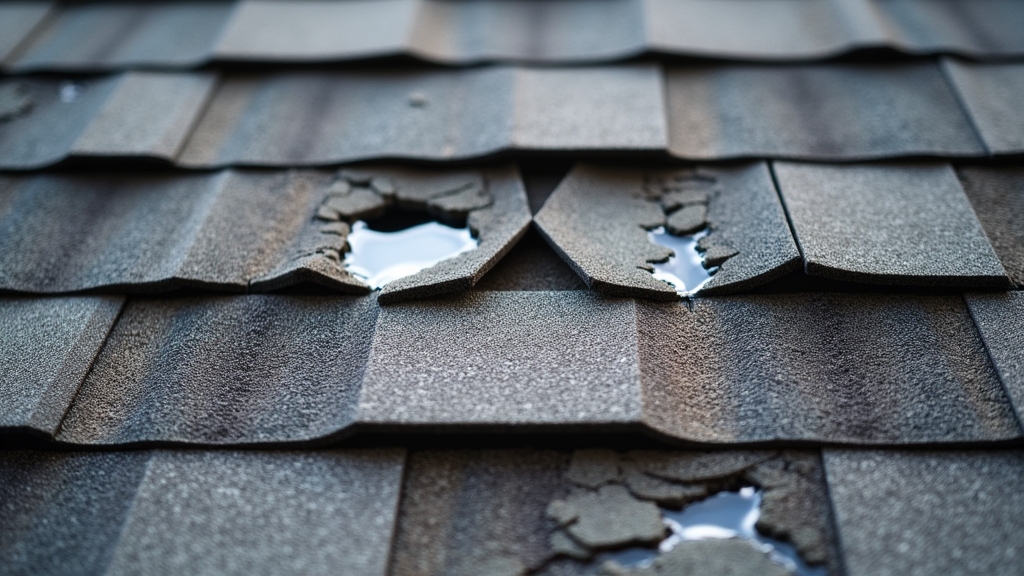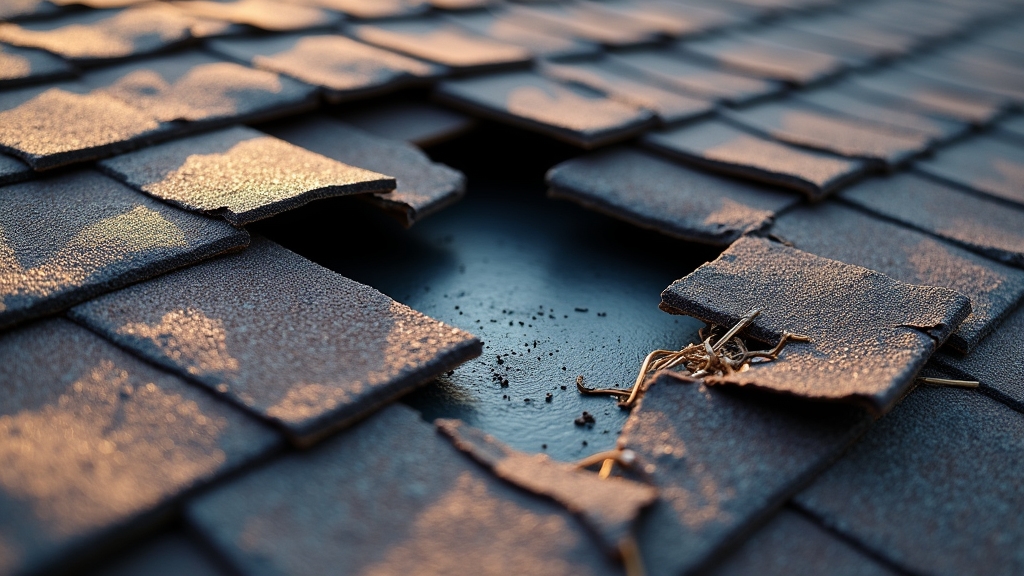Homeowners should assess their roofs for signs of damage such as missing, cracked, or curling shingles, dark streaks, and granule loss in gutters. Interior water stains and sagging roof decks often indicate more serious issues. Additionally, increased energy bills may signal roofing inefficiencies. Mold growth may also be a concern in damp environments. Engaging a professional for a thorough inspection can help identify underlying problems and guide whether repair or replacement is necessary for ideal safety and durability.
Key Takeaways
- Inspect for missing, cracked, or curling shingles, which may indicate the need for repair or replacement due to moisture exposure.
- Look for dark streaks or discoloration, suggesting algae or mold that could compromise roof integrity and warrant replacement.
- Check for granule loss in gutters, as significant deterioration may necessitate a roof replacement to maintain effectiveness.
- Assess the age of your roof; roofs over 20 years old may require replacement despite minor damage due to advancements in roofing technology.
- Monitor for interior water stains and sagging roof decks, indicating potential leaks and structural issues that often require professional evaluation.
Signs of Roof Damage to Watch For

Identifying signs of roof damage is essential for homeowners seeking to maintain the integrity of their property. Common indicators include missing, cracked, or curling shingles, which may expose underlying materials to moisture.
Additionally, dark streaks or discoloration often signify algae or mold growth, compromising the roof’s longevity. Homeowners should also inspect for granule loss in gutters, as this diminishes shingle effectiveness.
Dark streaks on your roof may indicate algae growth, while granule loss in gutters can reduce shingle effectiveness.
Interior signs, such as water stains on ceilings or walls, may indicate leaks that warrant immediate attention. Inspecting flashing around chimneys and vents is critical; damaged or improperly sealed flashing can lead to significant water infiltration.
Moreover, sagging areas on the roof surface can suggest structural issues or rot. Routine inspections, especially after severe weather events, can help identify these signs early, allowing for timely intervention and potentially preventing costly repairs or replacements.
Mastery of these indicators is essential for effective roof maintenance.
The Age of Your Roof
The lifespan of a roof is a critical factor in determining whether repair or replacement is necessary. Typically, asphalt shingle roofs last 15 to 30 years, while metal or tile roofs can endure 50 years or more. As a roof approaches the end of its expected lifespan, deterioration may become evident, influencing structural integrity and performance.
Homeowners should conduct regular assessments, considering not just age but also material quality and installation practices. Documentation of maintenance history can be invaluable in evaluating a roof’s condition.
For roofs over 20 years old, even minor damage may warrant a replacement rather than a costly repair, as older materials may be less resilient. Additionally, advancements in roofing technology may offer superior options that enhance energy efficiency and longevity.
Ultimately, understanding the age of one’s roof enables informed decisions regarding ongoing maintenance versus the necessity for a complete replacement.
Missing or Damaged Shingles

The presence of missing or damaged shingles can greatly compromise the integrity of a roof.
It is essential to identify the types of shingles used, as variations in material can affect both durability and repair methods.
Moreover, evaluating the severity of the damage is vital to determining whether repair or complete replacement is the more viable solution.
Identify Shingle Types
A significant number of homeowners may overlook the condition of their roof shingles until visible damage occurs.
Understanding shingle types is essential for effective roof maintenance. Asphalt shingles, the most common, are available in three-tab and architectural styles. Three-tab shingles consist of a single layer and offer a flat appearance, while architectural shingles have multiple layers, providing enhanced durability and aesthetic appeal.
Wood shingles, typically cedar, are prone to rot but offer a natural look. Metal shingles, known for longevity, can be susceptible to rust without proper treatment.
Finally, slate shingles, while exceptionally durable, require careful installation and support due to their weight. Identifying the specific type of shingle enables homeowners to assess maintenance needs and potential repairs accurately.
Assess Damage Severity
How can homeowners effectively assess the severity of damage caused by missing or damaged shingles? A systematic evaluation is essential.
Homeowners should initiate by conducting a visual inspection from the ground, identifying areas with missing, curled, or cracked shingles. Utilizing binoculars can enhance visibility.
Next, they must check for granule loss on the shingles, as this indicates deterioration. A close inspection of the roof deck beneath the shingles is also crucial; any signs of water infiltration may necessitate immediate attention.
Additionally, homeowners should consider the age of the roof—shingles older than 20 years typically require replacement.
Finally, consulting with a roofing professional for a thorough assessment can provide invaluable insight into whether repair or replacement is warranted.
Water Stains on Ceilings and Walls

While water stains on ceilings and walls often signal underlying issues, their presence is not always indicative of a failing roof. These stains may arise from various sources, including plumbing leaks, condensation, or insufficient ventilation. Analyzing the location and pattern of the stains is critical; for instance, stains directly beneath plumbing fixtures may point to pipe issues rather than roofing problems.
To ascertain the true cause, a methodical inspection should be conducted, involving both the interior and exterior of the structure. Look for signs of damage to roofing materials, such as missing shingles or compromised flashing, as these can contribute to water intrusion.
Additionally, consider environmental factors like heavy rainfall or snow accumulation, which may exacerbate existing vulnerabilities. Ultimately, accurate diagnosis requires an extensive understanding of both roofing systems and building envelope performance, ensuring that appropriate remedial actions—repair or replacement—are effectively determined.
Sagging Roof Deck
Numerous indicators can suggest the presence of a sagging roof deck, a condition that often signals serious structural issues. A visible dip or sagging in the roofline may be observed, particularly along the rafters or trusses. This deformation can result from various factors, including excessive weight from accumulated snow, water damage, or deterioration of roofing materials.
Additionally, the presence of cracks in interior walls or ceilings may accompany a sagging roof, indicating compromised structural integrity. It is imperative to assess the roof deck’s support system, as failure to address these issues can lead to significant safety hazards, including potential collapse.
Professional evaluation is recommended to determine the extent of the damage and to devise an appropriate remediation strategy. Ignoring a sagging roof deck not only jeopardizes the overall stability of the structure but also incurs higher repair costs over time. Immediate attention is essential for maintaining long-term structural health.
Granules in Gutters
The presence of granules in gutters serves as an important indicator of roof integrity, as these small particles are essential for protecting shingles from UV radiation and weathering.
When granule loss occurs, it can lead to decreased effectiveness of the roofing material, exposing the underlying layers to potential damage.
Monitoring granules in gutters is vital for evaluating the overall health of a roof and determining whether repair or replacement is necessary.
Purpose of Roof Granules
Roof granules serve a critical function in the overall performance and longevity of roofing materials, particularly asphalt shingles. These granules provide essential UV protection, minimizing thermal expansion and contraction that can lead to material degradation. Additionally, they enhance the aesthetic appeal of roofing systems while contributing to fire resistance. The presence of granules in gutters can indicate the erosion of shingles, which may compromise these protective qualities.
| Function | Description |
| UV Protection | Shields shingles from harmful sunlight |
| Aesthetic Appeal | Offers color and texture variety |
| Fire Resistance | Reduces flammability of roofing |
| Thermal Regulation | Minimizes heat absorption |
| Water Shedding | Promotes effective drainage |
Signs of Granule Loss
Granule loss is a significant indicator of roofing system deterioration, often evidenced by the presence of granules accumulating in gutters.
These granules, which serve to protect the underlying asphalt from UV radiation and physical damage, can detach due to age, weathering, or manufacturing defects.
When inspecting gutters, the presence of excessive granules is an alarming sign, suggesting that the shingles may be losing their protective layer. Homeowners should assess the quantity of granules found, as a significant buildup may signal an urgent need for further evaluation.
Furthermore, consistent granule loss can compromise the roof’s integrity, leading to potential leaks and other structural issues.
As a result, monitoring gutter contents is essential in determining the health of the roofing system.
Implications for Roof Health
When excessive granules accumulate in gutters, it signifies deeper issues within the roofing system that warrant immediate attention. Granules serve as a protective layer for shingles, shielding them from UV radiation and environmental elements. Their loss indicates deterioration, potentially due to age, improper installation, or extreme weather conditions.
Accumulated granules can lead to clogged gutters, exacerbating water damage risks and accelerating the onset of mold or rot in the underlying structural components. Additionally, significant granule loss may compromise the roof’s warranty, as manufacturers often stipulate that adequate granule coverage is essential for peak performance.
Homeowners should conduct regular inspections and consult with a roofing professional to assess the implications of granule accumulation, ensuring informed decisions regarding repair or replacement.
Increased Energy Bills
A notable increase in energy bills can often signal underlying issues with a home’s roofing system. This phenomenon typically arises when the roof fails to provide adequate insulation or ventilation, leading to inefficiencies in heating and cooling.
Homeowners should consider the following factors that may contribute to escalating energy costs:
- Damaged shingles or tiles: Compromised roofing materials can allow heat loss or gain, disrupting indoor temperature regulation.
- Inadequate insulation: Insulation that is insufficient or deteriorated can exacerbate energy inefficiencies, forcing HVAC systems to work harder.
- Poor ventilation: A lack of proper airflow can cause moisture build-up and temperature imbalances, further straining energy systems.
Addressing these roofing deficiencies promptly is vital to maintaining energy efficiency and reducing long-term costs.
Regular inspections and timely repairs or replacements are essential to ensuring the roofing system functions at its best, ultimately safeguarding both financial resources and comfort.
Mold or Mildew Growth
Increased energy bills may often be symptomatic of deeper issues, including the presence of mold or mildew growth within the roofing system.
Mold and mildew thrive in moist, poorly ventilated environments, often resulting from leaks or inadequate drainage. These fungi can compromise the structural integrity of roofing materials, leading to rot and decay.
The identification of mold or mildew typically manifests as dark stains or discoloration on the roof’s surface, which may be accompanied by a musty odor.
Advanced growth can infiltrate insulation and compromise indoor air quality, posing health risks to inhabitants.
Regular inspections and moisture assessments are essential to detect early signs of mold or mildew proliferation.
Addressing the source of moisture, such as leaks or condensation, is imperative to mitigate further growth.
Failure to act can necessitate extensive repairs or complete roof replacement, underscoring the importance of proactive maintenance in preserving the roofing system’s longevity.
Professional Inspection Benefits
How can homeowners guarantee the longevity and integrity of their roofing systems? Engaging a professional inspector offers invaluable benefits that can greatly impact roofing performance and lifespan.
Expert assessments identify issues not immediately visible to the untrained eye, ensuring proactive measures are taken.
- Thorough Evaluation: Professionals utilize advanced tools and techniques to assess structural integrity and materials.
- Preventive Insights: Early detection of potential problems enables timely interventions, mitigating costly repairs or premature replacements.
- Compliance Assurance: Inspections guarantee adherence to local building codes, enhancing safety and property value.
Frequently Asked Questions
How Much Does Roof Repair Typically Cost?
Roof repair costs typically range from $300 to $1,500, depending on factors such as damage extent, materials used, labor rates, and geographic location. Thorough assessments guarantee accurate estimates and informed decision-making regarding necessary repairs.
Can I Repair My Roof Myself?
Repairing a roof independently is feasible for those possessing adequate skills and tools. However, one must assess structural integrity, local regulations, and safety protocols, as improper repairs may lead to further complications and increased costs.
What Materials Are Best for Roof Replacement?
The most suitable materials for roof replacement include asphalt shingles for cost-effectiveness, metal for durability, slate for longevity, and tiles for aesthetics. Each material offers distinct advantages, emphasizing energy efficiency, weather resistance, and maintenance requirements.
How Long Does a Roof Replacement Process Take?
The roof replacement process typically spans from one to three days, contingent upon factors such as roof size, material type, and weather conditions. Proper planning and skilled labor are essential for efficient execution and completion.
Will Homeowners Insurance Cover Roof Repairs?
Homeowners insurance typically covers roof repairs if damage results from covered perils, such as storms or vandalism. Policy specifics vary considerably, necessitating thorough examination of coverage limits, deductibles, and claim processes outlined in individual insurance agreements.
Final Thoughts
In summary, determining whether your home needs a roof repair or a full replacement depends on several critical factors — the roof’s age, visible damage, water intrusion, and overall efficiency. Signs such as missing shingles, granule buildup in gutters, or rising energy bills shouldn’t be ignored, as they often indicate deeper structural or insulation problems. Professional inspections play a vital role in assessing these issues accurately and preventing costly damage down the line.
For expert evaluation and dependable solutions, trust 180 CONTRACTORS ROOFING STERLING HEIGHTS — your local roofing specialists serving Sterling Heights and surrounding areas including Troy, Rochester Hills, and Warren.
Our experienced team provides comprehensive roof inspections, roof repairs, and full roof replacements using high-quality materials such as asphalt shingles and metal roofing. We ensure lasting protection, energy efficiency, and exceptional craftsmanship for every project.Call (586) 331-0594 or contact us online today for a free, no-obligation roof inspection or estimate — and let 180 CONTRACTORS help you safeguard your home with trusted, long-lasting roofing solutions.
